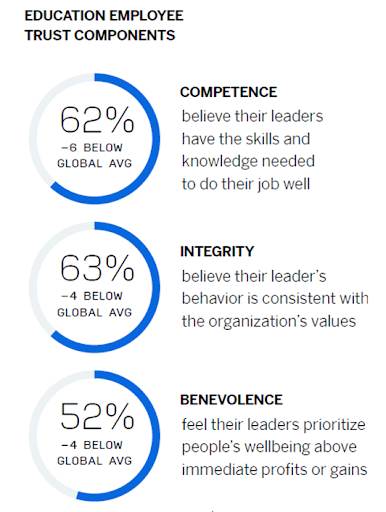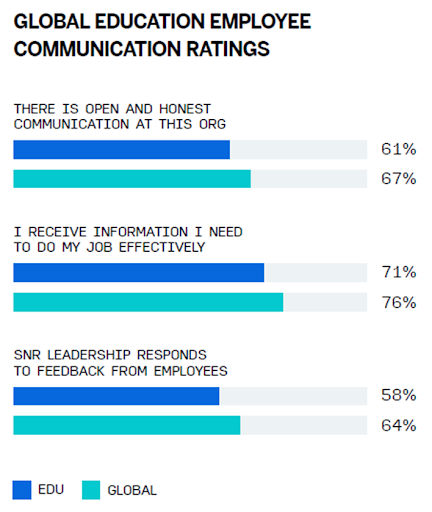A stable cohort of qualified teachers and support staff who stay long term at the same school delivers the best outcomes for their students, fellow teachers, school leaders and the wider community. They get to know their students, their colleagues, the parents, and the way things are done at the school, and awareness of external factors that may affect learning.
Yet the K-12 education system and teacher workforce are facing a serious talent crisis that in many cases has nothing to do with the school itself. Changes in funding, the rising cost of living, and fluctuations in the job market all have had knock-on effects influencing teachers’ and staff’s decisions to stay or leave their jobs.
Our research into the education sector has found, in addition, that trust and satisfaction in the education sector are beginning to decline, communication challenges are leading to poor experiences, and the rapid advance of technology must not be allowed to replace the human connection that is at the heart of education.
We found:
- 33% of teachers are contemplating leaving their jobs
- 49% of public schools report non-teaching staff vacancies
- 44% of teachers report feeling burned out ‘often’ or ‘always’
Education stands at a crucial crossroads. Schools have traditionally been places of trust and influence, shaping minds, fostering growth, and building the foundations for the future. We need them to stay that way. So what can be done to keep the very people who drive such excellence?
What is teacher retention?
Teacher retention is the ability of schools or other educational establishments to keep their teaching staff long term. A high retention rate is indicative of a stable, experienced workforce, whereas a low retention rate indicates frequent employee turnover with its attendant teacher shortages, instability and inexperience.
Every company, sector, and industry, including education, has its own retention rate. It’s calculated by dividing the number of employees remaining at the end of a period (like an academic year, for education) by the number of employees present at the beginning of that period, and multiplying by 100 to get the percentage:
So if 6 employees left out of an average staff of 65, your turnover rate would be 9.23%.
For the 2023-2024 school year, the national principle turnover rate was 8%, which has halved from its previous high of 16% right after the pandemic.
Why teacher retention is important
When effective teachers stay at their schools, the whole educational system benefits and improves in the areas of:
Student outcomes
When schools retain teachers and support staff, they create continuity and build long-term, nurturing relationships between educators and their students. Frequent turnover, by contrast, disrupts learning and negatively affects students’ engagement, and achievements.
School budgets
Without the considerable expense of constantly recruiting and training early career teachers and staff, schools can spend that money on different priorities such as facilities, technology, and resources to benefit students.
Larger school districts can spend, on average, up to $25,000 replacing an existing teacher, when expenses related to departure, recruitment, hiring, and training are factored in. That’s a lot of the budget walking out of the main entrance.
Staff morale
The school staff room is more often than not a place of camaraderie, support, good humour, creative ideas and the sharing of experience between high-performing teachers and less experienced teachers who may be in their early career stages. When teacher turnover within such a tight-knit community is high, remaining colleagues may experience low morale, reduced productivity, overwork and instability, which in turn affects students and the school climate as a whole.
Benefits to the less privileged
Perceived understaffing in schools that serve high-poverty neighborhoods can be up to 57%, and it’s well known that high teacher turnover rates adversely affects children’s education, particularly the poorest ones, and those with special education needs, the hardest.
Knowledge and experience
Experienced teachers know their school and their students inside out. Their input is vital when it comes to identifying needs and developing solutions. When they leave, their experience is lost and overall teacher quality may suffer.
Teacher turnover and student achievement
When permanent teachers leave, substitute teachers are brought in. It’s hard for early career teachers to step into the previous, more experienced teacher’s shoes, particularly midway through the academic year. Substitutes may be less qualified and experienced, lacking teacher preparation. They may not know what makes their students excited and engaged about learning, which may lead to disruption, classroom management issues and poor scholastic achievement.
Other negatives of teacher turnover include:
Reduced student performance
When novice teachers are placed in classrooms, there may be disruption due to lack of discipline, less continuity of care, challenges with teaching the topics, and unfamiliarity.
Emotional cost
We all remember a favorite teacher at school – they may have been particularly kind, strict but fair, inspirational, helped us understand something we struggled with or acted as a mentor or role model. For many students, a favorite teacher is irreplaceable, and if they leave, it can be particularly upsetting. Students missing an influential teacher may disengage, participate less, and achieve lower grades.
Larger class sizes
A shortage of teachers may mean class sizes have to be bigger than usual, students may find it harder to receive individual attention, and fall behind in certain subjects. Schools may also have to cut offerings of certain subjects that some students excel in.
Decline of school culture
High teacher turnover can discourage remaining staff from investing their time and efforts in long-term goals and community-building within the school, negatively affecting those students who would most benefit from such initiatives.
Why do teachers leave?
There are many reasons why there are so many teacher resignations just now. Open any report on the state of public education, and: poor onboarding and preparation, lack of support, challenging working conditions, dissatisfaction with pay and benefits, and better career opportunities elsewhere will be near the top of a list explaining teacher attrition.
Our own research, in our 2025 State of Experience in Education uncovered four reasons for teachers leaving the profession that you may not have thought of, but which, given the right educational leadership, can be rectified.
Lack of trust in leadership
Trust is the foundation on which effective and high impact educational institutions and school systems are built, and in 2025 it is getting harder to maintain.
Just over half (59%) of employees in K-12 (primary and secondary) trust their senior leaders, which is four percentage points lower than the global average.
Trusted leaders demonstrate three key characteristics: competence, integrity, and benevolence:

The low trust in leadership score for education is mainly driven by low ratings for benevolence: the belief that leaders will choose people’s wellbeing over immediate profit or gain. There’s clearly work to be done reassuring teachers and staff that leadership cares about their wellbeing above profit, and need to prioritize employee stress reduction and additional support for them.
Poor communication
61% of employees in the education sector agreed that ‘there is open and honest communication at this organisation’, against 67% globally – clearly this is an area that needs some improvement. Educators also lag behind receiving information they need to do their jobs effectively, and in getting response from senior leadership to their feedback:

Lack of support for adapting to change
Our research finds that the education sector falls behind on supporting employees through change, which is failing to equip staff with the processes, support and improvements they need. 70% of educators report having processes that enable them to meet students’ needs, 5 percentage points below the global average.
If teachers are to keep pace with the changing needs of students and communicate effectively, they need systemic support to do so.
Using AI in the right way
AI is already here, and like it or not, teachers, staff and students are using it. Our 2025 Employee Experience Report found that 45% of employees are already using AI tools at work, daily or weekly. These tools are:

Clearly a mishmash of AI tools plucked from a variety of sources. In education, AI presents both challenges and opportunities. While the rate of AI adoption is slightly lower in education compared to other industries, this is most likely due to a lack of training, enablement, guidelines and access to AI tools from their employers. AI needs to be used as a tool to ease the administrative burden on teachers, rather than in areas that require personal interaction, such as student advising, financial aid, or mental health support.
Teacher retention strategies
Unfortunately, there’s no quick fix for staff and teacher turnover, even when you identify the many causes. It would be too simplistic to say, “Pay more”, “Communicate more”, or “Support your staff more”. Effective retention strategies need a deep understanding of the root causes of disengagement and the nuanced factors that influence staff’s decisions to stay or leave – and targeted action.
Why traditional approaches to teacher retention fall short
Asking your teachers and staff for feedback about their experiences is always the best way to find out what’s going on in the classrooms and staffrooms. The teacher survey has been the traditional go-to mechanism, but it has shortcomings:
It’s siloed
Many school districts rely on infrequent surveys - typically only the annual one - that give only a superficial snapshot of teacher and staff sentiment. This type of survey is cumbersome, difficult to design effectively, and often lacking the depth to uncover root causes of issues such as burnout. It’s also usually siloed, disconnected from the school’s core HRIS/HCM systems.
It’s complex to analyze
School HR teams are busy and stretched for time, skills, and resources as it is, so analyzing complex, often unstructured feedback data (like open-ended survey responses) is a major task, especially without easy-to-use analytical tools and dashboards.
It can paralyze action
There’s usually a time lag between data collection, analysis, and leadership decisions. The golden rule with feedback is that for it to be effective, and trusted, it must be acted upon. School and district leaders often struggle to pinpoint the critical insights from complex data and may lack the knowledge to take evidence-based actions that would improve teacher and staff engagement and retention.
Getting started with improving teacher retention is easy
In education, the employee experience encompasses everything a teacher or support staff learns, does, sees, and feels from the moment they notice a job opening, to their last day in your district. Every interaction shapes their perception of the district as an employer and directly impacts their commitment and performance.
To cultivate a thriving workplace culture that attracts and retains high quality educators - ultimately benefiting students and their success - school districts must strategically design and shape a compelling employee experience, powered by a suitable technology platform, and grounded in three interconnected practices:
Listen to capture the full educator experience
The foundation of any successful employee experience strategy, teaching or otherwise, lies in effective listening. You need to take a step back and understand:
- what you want to measure
- why you want to measure it
- who to collect feedback from
This will ensure that the feedback gathered will provide the actionable insights needed to improve the employee experience of teachers.
For a full listening experience, use multichannel listening (e.g. surveys, email, SMS, QR codes) so everyone can give feedback in ways that are easy and convenient for them.
Understand the root causes of teacher turnover
Listening and gathering employee feedback is just the first step. That feedback then needs to be analyzed into actionable insights, identifying factors that affect teacher retention, well-being, and engagement.
When this feedback is connected with the HRIS, HCM, crucial context – the who, what, where, and why – emerges so you can make targeted solutions. For example, by linking feedback about new teachers’ workload with absence data, you’ll see clearly how too much work leads to time off in that cohort.
Act on feedback and drive continuous improvement
Feedback is nothing without action. The best employee experience platforms help schools act on issues swiftly and visibly. With automated workflows, concerns can be routed to the appropriate teams, such as IT or HR. You can also include collaborative action planning, providing teachers and staff with a platform to propose ideas anonymously and vote on the ones that resonate.
How Qualtrics® can help your teacher retention strategies
Qualtrics XM® for Education allows schools to listen to real-time student, faculty, teacher and staff feedback wherever they are — through surveys, online reviews, call center conversations, social media, and more.
With that data at your fingertips, schools can better understand how their students, teachers and staff are feeling and what actions they need to take to boost engagement and teacher retention in an ever-changing academic market.



